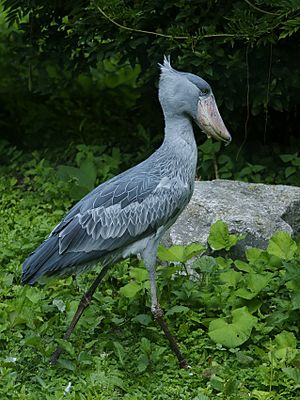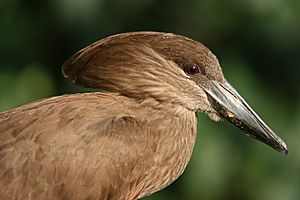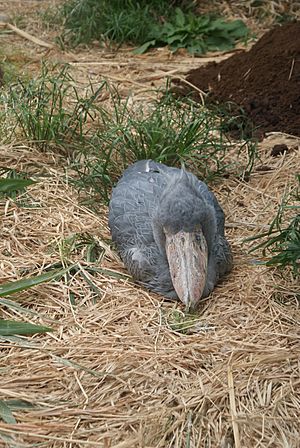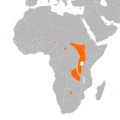Shoebill facts for kids
Quick facts for kids Shoebill |
|
|---|---|
 |
|
| At the Pairi Daiza in Brugelette, Belgium | |
| Conservation status | |
| Scientific classification | |
| Genus: |
Balaeniceps
|
| Species: |
rex
|
 |
|
| range | |
The shoebill (Balaeniceps rex) is a very large bird with long legs. It is also called the whale-headed stork or shoe-billed stork. It gets its name from its huge, shoe-shaped bill. Shoebills live in tropical East Africa in big swamps. You can find them from South Sudan all the way to Zambia. Adult shoebills are mostly grey, while younger ones are more brown.
Contents
About the Shoebill's Name and Family

People might have known about the shoebill in Ancient Egypt. But it was not officially named until the 1800s. This happened after some bird skins and live birds were brought to Europe.
A scientist named John Gould first described the shoebill in 1850. He named it Balaeniceps rex. The name Balaeniceps comes from Latin words meaning "whale" and "head". This is because of its big, whale-like head.
For a long time, scientists thought shoebills were related to storks. But newer studies of their DNA show they are actually closer to pelicans and herons. This means they belong to a different bird group called Pelecaniformes.
Scientists have also found fossils of two ancient relatives of the shoebill. These fossils help us understand the shoebill's long history.
What Does a Shoebill Look Like?
Shoebills are very tall birds. They usually stand about 110 to 140 cm (43 to 55 in) high. Some can even reach 152 cm (60 in)! Their wings can spread out very wide, from 230 to 260 cm (7 ft 7 in to 8 ft 6 in).
The most special thing about the shoebill is its giant, bulb-shaped bill. It looks like a straw-colored shoe with grey marks. This bill is one of the longest among all birds. It is also very wide, like a pelican's bill. The top part of the bill has a strong ridge and ends in a sharp point.
Shoebills have long, dark legs and very large feet. Their big feet help them stand on plants floating in the water while they hunt. Their neck is shorter and thicker than other long-legged birds. Their wings are wide, which helps them glide through the air.
Feathers and Young Shoebills
Adult shoebills have blue-grey feathers. Their flight feathers are a darker grey. Young shoebills look similar but are a darker grey with a brownish tint.
When shoebill chicks are born, their bill is smaller and silvery-grey. It starts to grow much bigger when they are about 23 days old. By 43 days, their bill looks like the adult's.
How Shoebills Communicate
Shoebills are usually quiet birds. But they make a clapping sound with their bills at the nest. This is called "bill-clattering." Adult birds also make a sound like a cow's "moo" and high-pitched cries. Both young and adult shoebills use bill-clattering to talk to each other during nesting time.
When baby shoebills want food, they make a sound that sounds like human hiccups! Sometimes, a flying adult shoebill might make a rough croaking sound. This can happen if it feels threatened, like by a nearby marabou stork.
How Shoebills Fly
When a shoebill flies, it holds its wings flat. Like pelicans, it flies with its neck pulled back. Shoebills flap their wings very slowly, about 150 times per minute. This is one of the slowest flapping rates of any bird. They fly by flapping and then gliding for about seven seconds.
Shoebills usually do not fly very far. If they are scared, they might fly only 100 to 500 m (330 to 1,640 ft). Long flights are rare for them.
Where Shoebills Live and Their Home
Shoebills live in freshwater swamps in central tropical Africa. You can find them in southern Sudan, South Sudan, parts of the Congo, Rwanda, Uganda, western Tanzania, and northern Zambia. They are most common in South Sudan and Uganda.
These birds like areas with lots of papyrus plants and reedbeds. They also like places where the water does not have much oxygen. This makes fish come to the surface to breathe, which makes them easier for the shoebill to catch.
Shoebills do not move around much. They stay in the same area unless their habitat changes. For example, if there is less food or if humans disturb them.
Long ago, during the Early Holocene period, shoebills lived much further north. Ancient rock carvings in Algeria show that shoebills were in the wetlands that used to cover the Sahara Desert.
Shoebill Behavior and Lifestyle
Shoebills are known for moving very slowly and staying still for a long time. They look like statues! They are also very shy around people. If humans get too close to their nests, they might leave them.
Shoebills are often found in swamps and bogs where fish come to the surface for air. They also seem to move based on water levels. Young shoebills leave nests if water levels go up, while adults leave if water levels go down. Both prefer stable water levels.
Even though they are big, shoebills often stand on floating plants. This makes them look a bit like a giant jacana. Shoebills are usually alone. They hunt far apart from each other, at least 20 m (66 ft) away.
When hunting, a shoebill walks very slowly and often stops. They use their excellent eyesight to find prey. Unlike some other birds, they do not feel for prey in the water. Once they spot prey, they strike very quickly and powerfully. About 60% of their strikes catch something. They often scoop up water and plants with their prey, which then spills out of their bill. Sometimes, hippopotamuses help shoebills by accidentally forcing fish to the surface.
Reproduction and Life Cycle

Shoebills are solitary even when they breed. Their nests are usually far apart from each other. A pair of shoebills will strongly protect their nesting area, which can be 2 to 4 km2 (0.77 to 1.54 sq mi) big.
Nesting usually starts after the rainy season ends. Both parents build a large, flat nest on a floating platform. The nest is made of water plants and can be 1 to 1.7 m (3.3 to 5.6 ft) wide.
The female shoebill lays one to three white eggs. Each egg weighs about 164 g (5.8 oz). The eggs hatch after about 30 days. Both parents take turns sitting on the eggs, shading them, guarding them, and feeding the chicks.
Shoebills have a special way to cool their eggs. On hot days, they scoop up water in their bill, swallow some, and then pour the rest onto the nest and eggs. They then spit out the water they swallowed onto the nest too.
Parents feed their young by bringing whole food items from their throat directly into the chick's bill. Shoebills rarely raise more than one chick. The younger chicks often do not survive. They act as "back-ups" in case the oldest chick dies.
Young shoebills can fly well by about 112 days old. But their parents still feed them for another month or more. It takes young shoebills three years to become fully grown and ready to have their own chicks.
What Shoebills Eat
Shoebills mainly eat fish. But they also hunt many other animals that live in wetlands. Their favorite foods include marbled lungfish, African lungfish, and different kinds of catfish.
They also eat frogs, water snakes, Nile monitor lizards, and baby crocodiles. Sometimes, they might eat small turtles, snails, rodents, small water birds, or even dead animals.
Because of its sharp, huge bill, the shoebill can catch very large prey. They often hunt prey that is bigger than what other large wading birds would try to catch. In some areas, they catch fish that are 15 to 50 cm (5.9 to 19.7 in) long. They have even caught fish up to 99 cm long! If the fish is very big, they will cut it into pieces before swallowing it. This whole process can take from 2 to 30 minutes.
Sometimes, other birds like the African fish eagle try to steal the shoebill's large prey.
Shoebills and Humans
Many birdwatchers consider the shoebill one of the most exciting birds to see in Africa. They are usually calm around humans and do not act aggressively. Researchers have even been able to watch a shoebill on its nest from very close, about 2 meters (6 ft 7 in) away.
Shoebills are often kept in zoos. However, it is rare for them to have babies in zoos. Some zoos, like Pairi Daiza in Belgium and Tampa's Lowry Park Zoo in Florida, have had success with shoebill breeding.
Protecting the Shoebill
There are an estimated 5,000 to 8,000 shoebills left in the world. Most of them live in swamps in South Sudan, Uganda, eastern Democratic Republic of the Congo, and Zambia.
BirdLife International has listed the shoebill as a vulnerable species. This means they are at risk of becoming endangered. The biggest dangers to shoebills are:
- Habitat destruction: Their homes are being destroyed or damaged.
- Disturbance: Humans bothering them.
- Hunting: People hunting them.
The shoebill is also protected under an international agreement called CITES. This agreement helps control the trade of endangered animals.
Farming and cattle grazing are causing shoebill habitats to shrink. Local communities sometimes collect shoebill eggs and chicks for food or to sell. Frequent fires, some started on purpose for grazing, also destroy their homes. Some swamps are even being drained for building projects, which further reduces their habitat.
Images for kids
-
At the Pairi Daiza in Brugelette, Belgium
-
The hamerkop is a close relative of the shoebill.
-
A shoebill sitting in Prague Zoo, Czech Republic.
See also
 In Spanish: Picozapato para niños
In Spanish: Picozapato para niños












